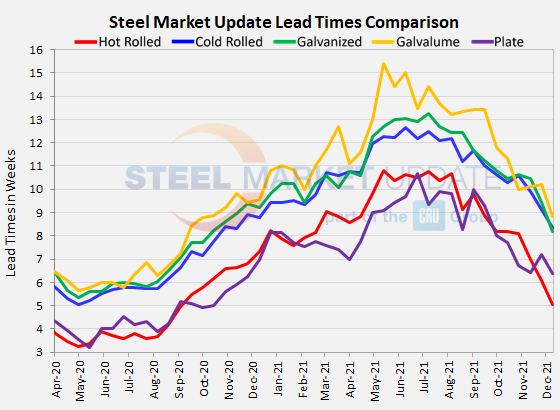SMU Data and Models

Steel Mill Lead Times: Hot Rolled Down to Five Weeks
Written by Tim Triplett
December 9, 2021
Lead times for steel sheet and plate continued to decline over the past two weeks, shortening by an average of more than a week. The move correlates with a sharp downtrend in steel prices.
Steel Market Update’s latest check of the market shows the average lead time for hot rolled orders nearing five weeks. Cold rolled and coated lead times are approaching eight weeks. That’s still 1-2 weeks longer than historical averages but far below the peaks of 11-13 weeks seen earlier this year. Current lead times are also the shortest they have been since September/October 2020, according to SMU data.
Buyers polled by SMU this week reported mill lead times ranging from 3-8 weeks for hot rolled, 5-12 weeks for cold rolled, 4-12 weeks for galvanized, 8-10 weeks for Galvalume, and 4-8 weeks for plate.
The average lead time for spot orders of hot rolled has declined to 5.04 weeks from 6.09 weeks in late November. Cold rolled lead times now average 8.35 weeks, a decline from 9.13 two weeks ago. Galvanized lead times dipped to 8.19 weeks from 9.42 weeks in the same period. The average Galvalume lead time moved down to 8.83 weeks from 10.20 weeks.
Like sheet products, mill lead times for plate also continue to shorten. The average plate lead time moved down to 6.38 weeks from the 7.20 weeks seen in SMU’s market check two weeks ago.
Lead times are a sign of activity and demand at the mill level and are considered a leading indicator of finished steel prices.

By Tim Triplett, Tim@SteelMarketUpdate.com

Tim Triplett
Read more from Tim TriplettLatest in SMU Data and Models

SMU’s June at a glance
A look at SMU data for the month of June.

SMU Survey: Buyers’ Sentiment rebounds from multi-year low
Both of SMU’s Steel Buyers’ Sentiment Indices edged higher this week. Current Sentiment rebounded from a near five-year low, while Future Sentiment rose to a two-month high

SMU flat-rolled market survey results now available
SMU’s latest steel buyers market survey results are now available on our website to all premium members.

SMU Survey: Sheet lead times pull back after early-June blip, plate holds
Following the uptick seen two weeks ago, lead times eased this week for all four sheet products tracked by SMU, while plate lead times held steady, according to this week’s market survey.

SMU Survey: Pricing power abruptly shifts to steel buyers
The majority of steel buyers responding to our latest market survey say domestic mills are more willing to talk price on sheet and plate products than they were earlier this month. Sheet negotiation rates rebounded across the board compared to early June, while our plate negotiation rate hit a full 100%.
